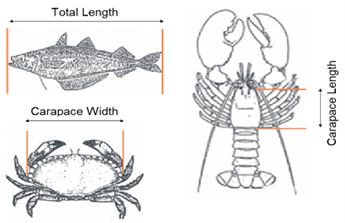IF YOU ARE FISHING OR SHORE GATHERING (INCLUDING DIVING) WITHIN THE NORTHUMBERLAND INSHORE FISHERIES AND CONSERVATION AUTHORITY DISTRICT, THE FOLLOWING WILL APPLY TO YOU
The Northumberland IFCA (NIFCA) is responsible for managing the exploitation of sea fisheries resources from the centre of the River Tyne to the Scottish border, out to six nautical miles and to the normal tidal limit of estuaries.
To ensure that the removal of sea fisheries resources is carried out in a sustainable way NIFCA put in place byelaws. The byelaws must be followed and apply to everyone.
Our uniformed Fishery Officers regularly patrol the district and they can inspect your catch and fishing gear. Their role is to enforce these byelaws and to help educate and inform visitors to the shore of them, so please approach them with any questions you have. The Officers have powers under national legislation and if you fail to comply with their instructions, you may be guilty of an offence.
Do you need a permit as a recreational fisher?
You do not need a permit to fish with a fishing rod or handline however undersize fish (as detailed below) must be returned to the sea immediately
You need a permit to fish using pots or traps. The permit costs £10 per year and allows you to fish up to 5 pots, with additional permit conditions.
You do not need a permit for shore gathering (including diving), but the following still apply:
Recreational fishers (without recreational permit) are only permitted to take per day up to:
1 lobster 20 whelks
5 brown or velvet crab 5 prawns
Recreational fishers (with recreational permit) are only permitted to take per day up to:
2 lobster 20 whelks
5 brown or velvet crab 5 prawns
ALL RECREATIONAL FISHERS
Prohibitions
The following animals must be immediately returned to the sea:
- Any lobster if tail is V-notched or mutilated tail. A V-notched is when a v shape is cut out of a lobster’s tail, a mutilated tail is where parts of a tail have been removed that may obscure a V-notch.
- Any lobster or brown crab with eggs (berries) attached. Do not remove the eggs.
- Any soft-shelled lobster or brown crab.
- Any detached parts of lobster or brown crab. This means any claws, tails and legs that cannot be measured for the minimum size.
- All animals caught must be above the minimum conservation reference size (see below for sizes)
Minimum conservation reference sizes
All animals caught must be above the following measurements.
| Fish Species | |
| Bass | 42 centimetres |
| Cod | 35 centimetres |
| Dover sole | 24 centimetres |
| Haddock | 30 centimetres |
| Herring | 20 centimetres |
| Ling | 63 centimetres |
| Mackerel caught within North Sea | 30 centimetres |
| Plaice | 27 centimetres |
| Pollack | 30 centimetres |
| Saithe (Coalfish) | 35 centimetres |
| Whiting | 27 centimetres |
| Mollusc Species | |
| Razor clam | 100 millimetres |
| Whelk | 45 millimetres |
| Crustacea Species | |
| European lobster | carapace – 87 millimetres |
| Norway lobster | whole – 85 millimetres
carapace – 25 millimetres tail – 46 millimetres |
| Edible brown crab | carapace – 130 millimetres |

Undersized animals are not to be retained and are to be returned to the sea immediately.
Code of Conduct
NIFCA have introduced codes of conduct for bait collection and hand gathering.
Blyth Estuary
NIFCA has developed a voluntary code of conduct for bait collection on the Blyth estuary. For further information on the Blyth code of conduct, please click HERE.
- Mussels should be collected for personal use only
- Only take mussels above a minimum size of 45mm shell length
- Take a recommended maximum of one small-medium sized bucket per day and avoid collection on every suitable tide
- Backfill holes
- Avoid walking or digging on live mussel
- Ensure you have the landowners permission before depositing tiles/tyres (or any other item)
- Materials such as stones and tiles are better for the environment than artificial objects such as tyres which may degrade and leach chemicals over time.
Periwinkle Gathering Code of Conduct
NIFCA have created a voluntary periwinkle gathering code of conduct for the NIFCA district. For further information on the periwinkle gathering code of conduct, please click HERE.
- Only collect periwinkles above 12mm (measured across the height of the shell from tip to tip) to avoid taking juvenile periwinkles
- Do not create unnecessary disturbance to birds as well as other animals and plants.
The full NIFCA byelaws are available at www.nifca.gov.uk
You can report any illegal activity on 01670 797676 or email nifca@nifca.gov.uk
All information correct at the time of publication (November 2022).
